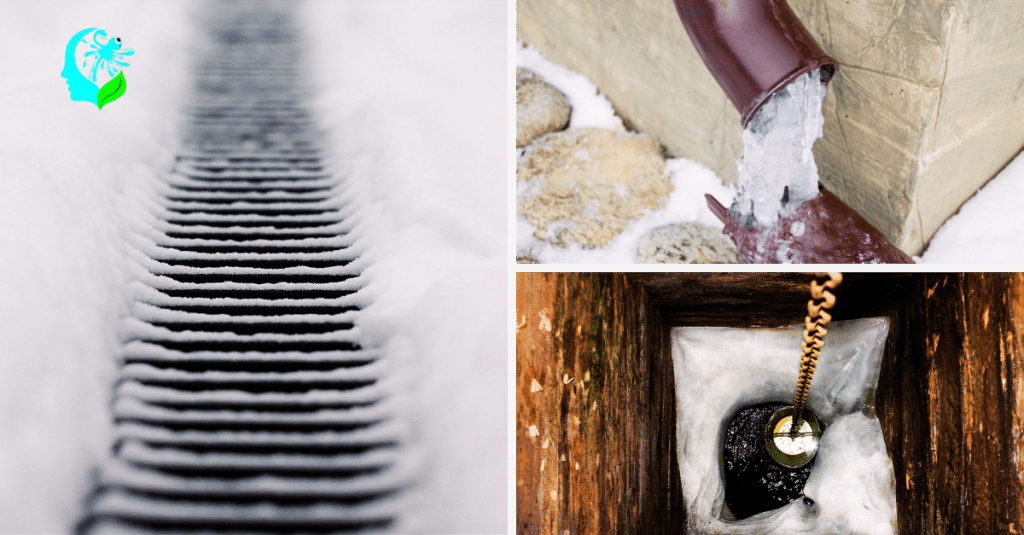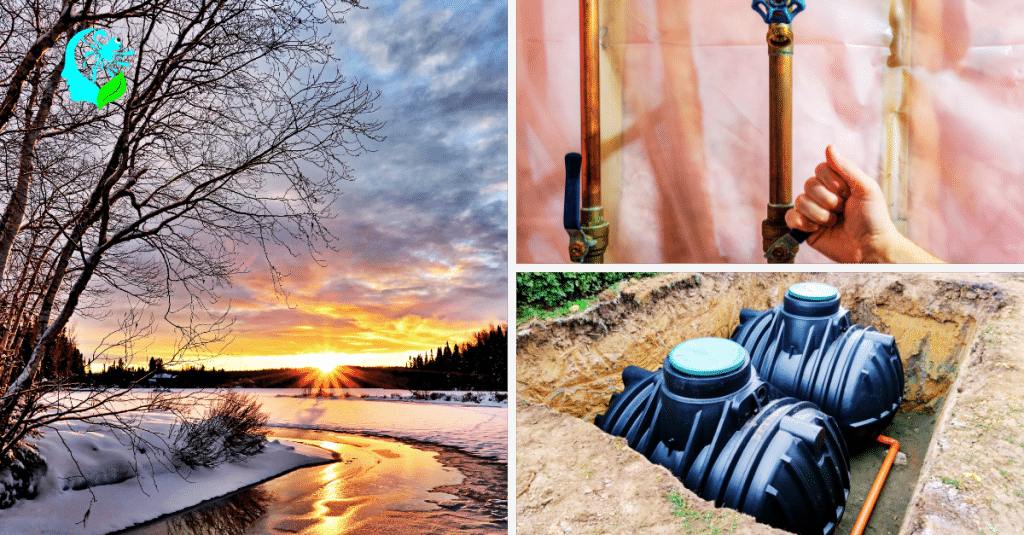Keeping Dual-Source Water Systems Quiet Reliable & Freeze Proof On The Homestead
UpRooted Greens introduces comprehensive curriculum for cold-climate dual-source water systems, teaching homesteaders to build reliable setups combining well water and rainwater with freeze protection, proper filtration, and energy efficiency.

Key Takeaways
- Underground cisterns and buried pipes below the frost line create a freeze-proof water system that works reliably even in harsh winter conditions
- Installing larger pressure tanks dramatically reduces pump cycling, saving battery power and extending pump life in off-grid systems
- Dual-source systems combining well and rainwater provide redundancy and resilience against both drought and power outages
- UpRooted Greens offers complete blueprints for building integrated water systems that seamlessly switch between sources while preventing common freeze failures
- The average homestead water system costs between $2,000-$15,000 depending on scale, with freeze protection being the most critical investment for northern climates
The Silent Water Crisis: Why Most Homestead Systems Fail in Winter
Water is the lifeblood of any homestead, but when temperatures plummet, it becomes your most vulnerable system. The quiet gurgle of water flowing through pipes can suddenly go silent as freeze damage creates a cascade of failures throughout your homestead.
I've seen countless homesteaders face the same crisis: pumps cycling all night draining precious battery power, pipes bursting after the first hard freeze, and water tanks rendered useless by thick ice. The problem isn't just inconvenience—it's a potential financial disaster that can leave you hauling water in buckets during the harshest months of the year.
The core issue is that most water systems are designed for moderate climates or grid-connected properties. When you're off-grid in a cold climate, you need solutions that work with minimal power while staying operational in sub-freezing temperatures. UpRooted Greens has developed comprehensive plans to address exactly these challenges that many homesteaders face.
But there's hope. After consulting with homesteaders across various climate zones, I've found that the most successful cold-climate water systems share three key characteristics: they combine multiple water sources, implement proper freeze protection, and use smart pressure management to minimize power consumption.
Dual-Source Systems: Combining Well and Rain for Year-Round Reliability
The strongest water systems draw from multiple water sources, with well water and rainwater harvesting being the ideal pairing. This redundancy provides insurance against both drought and equipment failure.
Well water offers consistent quality and volume but requires substantial power to pump. Rainwater, by contrast, uses gravity to your advantage and costs nothing to collect. When combined thoughtfully, these sources complement each other perfectly.
The magic happens in how you integrate these sources. A proper dual-source system allows you to:
- Capture rainwater during wet seasons, saving your well pump from unnecessary cycles
- Switch to well water during dry periods without any manual intervention
- Maintain water pressure even during power outages by leveraging gravity
- Keep critical components from freezing by sharing heat between systems
Many homesteaders report significant power savings after implementing a dual-source system. When your rainwater cistern is buried below the frost line, it provides gravity-fed water to the house while your well pump remains dormant for extended periods, activating only to refill the cistern during dry spells.
The key to making this work is proper switching between sources using check valves and smart plumbing design. Rather than two completely separate systems, the most efficient setup uses a unified pressure tank and filtration system that can draw from either source as needed.
Underground Protection: Keeping Water Flowing When Temperatures Plummet
The most effective defense against freezing is to work with the earth's natural insulation. Underground water systems utilize the planet's stable temperatures to maintain liquid water even during the harshest winters.
While surface temperatures might drop to -20°F or lower, the temperature four feet below ground typically remains above freezing year-round in most of North America. This natural phenomenon creates a perfect environment for water storage and distribution.
To capitalize on this natural protection, you need to:
- Bury your cisterns below the local frost line (usually 3-6 feet depending on your region)
- Run all water lines at least 12 inches below the frost line
- Insulate any above-ground components with foam pipe insulation or heat tape
- Create sloped drainage points to prevent water from standing in vulnerable areas
One crucial detail often overlooked: the point where underground pipes emerge from the ground is especially vulnerable. In these transition zones, consider using pipe insulation with an R-value of at least R-4, or wrapping the pipe with heat tape for additional protection.
Freeze-Protection Strategies That Actually Work
1. Below-Frost Burial: The Gold Standard
Nothing beats the reliability of keeping your entire water system below the frost line. This passive approach requires no electricity or ongoing maintenance—just proper initial installation.
For cisterns, this typically means excavating a hole at least 12 inches deeper than the frost line, creating a gravel bed for drainage, placing the tank, and backfilling carefully. The cistern access point should be insulated with a foam plug or hatch to prevent cold air infiltration.
For water lines, using flexible PEX tubing provides some protection against freezing due to its ability to expand slightly. However, burial depth is still the primary defense. Always run lines below the frost line, with particular attention to areas where the ground might be shallower (near rock outcroppings, for example).
2. Drain-Back Systems: Simple but Effective
For seasonal systems or components that can't be buried, drain-back design provides reliable protection. These systems automatically empty water from vulnerable pipes when not in use, eliminating the possibility of freeze damage.
The key to an effective drain-back system is proper slope (at least ¼ inch per foot) and strategically placed drain valves at low points. For garden hydrants or outdoor spigots, frost-free models that shut off below ground and automatically drain the riser pipe are worth the extra cost.
3. Active Heating: When to Use Heat Tape
While less energy-efficient than passive methods, heat tape has its place in a comprehensive freeze protection strategy. Modern heat tapes use between 3-9 watts per foot and can be self-regulating, activating only when temperatures approach freezing.
The most critical application for heat tape is at transition points where pipes move from below-ground to above-ground. These areas should be wrapped with heat tape and then insulated to trap the heat against the pipe.
For off-grid systems, low-wattage heat tape can be powered by a small solar panel and battery setup dedicated to freeze protection. This redundancy ensures your water keeps flowing even during extended cloudy periods.
4. Insulation Techniques That Prevent Problems
Proper insulation amplifies the effectiveness of your other freeze protection strategies. Beyond standard pipe insulation, consider these advanced techniques:
- Spray foam insulation in critical transition areas provides seamless coverage
- Insulated valve boxes filled with straw for emergency frost protection
- Heat-reflective pipe wrap to maximize the effectiveness of heat tape
- Multiple layers of insulation with staggered seams to prevent cold air infiltration
Remember that insulation alone won't prevent freezing in extreme conditions—it merely slows the process. Combine insulation with either burial below the frost line or active heating for complete protection.
Quiet, Solar-Friendly Pumping & Pressure Systems
Water pumps are typically the largest power consumers in an off-grid water system. Optimizing your pumping strategy can dramatically reduce your energy needs while extending equipment life.
The secret lies in minimizing pump cycles. Every time your pump starts, it draws a surge of power—often 3-4 times its running current. By reducing the frequency of these start-up surges, you can dramatically lower your overall energy consumption.
The most effective tool for reducing pump cycles is an appropriately sized pressure tank. While many conventional systems use 20-gallon pressure tanks, off-grid homesteads benefit from tanks in the 60-120 gallon range. These larger tanks allow your pump to run less frequently but for longer durations, which is more energy-efficient and extends pump life.
For a typical two-person homestead using 50 gallons per day, an 86-gallon pressure tank might reduce pump cycles from 20+ times daily to just 2-3 cycles. This not only saves energy but also reduces the noise pollution of a frequently cycling pump—a welcome benefit for peaceful homestead living.
Smart Source Integration: Seamless Switching Between Well and Rain
The true power of a dual-source system emerges when your plumbing seamlessly integrates both water sources. This integration allows automatic switching between well and rainwater without manual intervention.
The heart of this integration is a properly configured check valve system that prevents backflow while allowing water from either source to enter your home's plumbing. Here's how to design an effective integration:
- Install check valves on both the well line and cistern line before they join
- Position a pressure-sensing switch that activates the well pump only when cistern pressure drops below a set threshold
- Include manual shutoff valves for maintenance and seasonal adjustments
- Add a simple filtration system at each source before the integration point
With this configuration, your system will automatically draw from the rainwater cistern first (saving electricity), then seamlessly switch to well water if the cistern level drops too low. When rain refills your cistern, the system switches back to the gravity-fed source without any intervention.
Many homesteaders report significant reductions in energy use during rainy seasons, as gravity-fed rainwater handles daily needs without requiring pumping power.
Cold-Climate Filtration Essentials
Water filtration becomes particularly challenging in cold climates. Lower temperatures reduce the effectiveness of many filtration methods and can lead to clogged or frozen filter elements.
The key to successful cold-climate filtration is the proper sequence of treatments. The optimal arrangement is:
- Sediment filtration first - Removes particulates and extends the life of subsequent filters
- Carbon filtration second - Removes chemicals, odors, and some pathogens
- UV disinfection last - Neutralizes any remaining biological contaminants
For cold-climate success, house your filtration system in a heated space. Even a small insulated enclosure with minimal heating (a 25W bulb can suffice) will prevent freezing and improve filtration efficiency.
Also consider oversizing your primary filters. Cold water flows more slowly through filter media, so larger filter housings maintain adequate flow rates without creating pressure drops that could trigger unnecessary pump cycles.
Designing Your Frost-Proof System: A 4-Person Homestead Example
1. Calculating Your Daily Water Needs
For a family of four practicing conservative water use, plan for 30-50 gallons per person per day. This yields a daily demand of 120-200 gallons.
Breaking this down:
- Drinking and cooking: 1 gallon/person/day
- Bathing: 10-15 gallons/person/day
- Laundry: 15-20 gallons/load (assuming 2-3 loads weekly)
- Dishwashing: 3-5 gallons/day
- Toilet flushing: 5-15 gallons/person/day (depending on toilet efficiency)
For resilience, design your system to handle peak usage days (laundry + multiple showers) of approximately 250 gallons.
2. Sizing Your Cistern and Pressure Tank
For a four-person homestead, consider these minimum capacities:
- Primary cistern: 2,500-3,000 gallons (provides 10-14 days of complete independence)
- Secondary cistern or well backup: Able to deliver at least 300 gallons/day
- Pressure tank: 86-120 gallons (reduces pump cycles to 3-4 times daily)
If your property has significant elevation differences, you might position the main cistern at least 90 feet above your home to achieve approximately 40 PSI of gravity-fed pressure (based on the 0.43 PSI per foot of elevation formula).
3. Choosing the Right Pump for Dual Sources
In a dual-source system, your pump serves two functions: delivering well water directly to your home and occasionally refilling your cistern. This dual role requires careful pump selection.
For a 4-person homestead, look for these specifications:
- Flow rate: Minimum 10 GPM for good household pressure
- Lift capacity: Must exceed your well depth plus any elevation to cistern
- Power efficiency: DC pumps typically use less energy than AC pumps
- Soft-start feature: Reduces power surge when pump activates
4. Diagramming Your Freeze-Proof Plumbing
Your plumbing diagram should include:
- All pipes buried at least 12" below the local frost line
- Drain valves at low points for seasonal systems
- Heat tape at all ground-to-air transitions with proper insulation
- Check valves to prevent backflow between sources
- Pressure relief valves for safety
- Bypass options for each component to allow maintenance without full system shutdown
With properly installed and buried PEX tubing, your system can withstand even the harshest winter conditions without freezing. The slight flexibility of PEX also provides some protection against frost heave in extreme cold.

Real-World Costs: What to Budget for Your Dual-Source System
Building a comprehensive dual-source water system represents a significant investment, but one that pays dividends in reliability and resilience. Here's what to budget for a four-person homestead system:
- Well pump (if not already installed): $800-$2,000
- 3,000-gallon cistern: $2,500-$4,000 including excavation
- 120-gallon pressure tank: $500-$900
- PEX tubing and fittings: $600-$1,200 depending on distances
- Filtration system: $400-$1,000
- Freeze protection (heat tape, insulation): $200-$500
- Control systems and pressure switches: $300-$600
- Rainwater collection components: $500-$1,500
Total system cost: $5,800-$11,700
While this may seem substantial, consider that many homesteaders spend significantly more drilling a well alone, often without any backup source or freeze protection. A thoughtfully designed dual-source system provides greater resilience at a comparable or lower cost.
5 Common Water System Myths That Lead to Winter Failures
Over the years, I've encountered numerous myths that lead homesteaders into trouble. Let's dispel the most common ones:
Myth 1: "Moving water doesn't freeze"
Reality: Moving water freezes more slowly but will still freeze in sustained cold. Proper insulation and burial below the frost line are still essential.
Myth 2: "A bigger pump is always better"
Reality: Oversized pumps waste energy and cycle more frequently. Size your pump to match your actual needs, not theoretical maximums.
Myth 3: "Pipe insulation alone prevents freezing"
Reality: Insulation only slows freezing; it doesn't prevent it. In sustained cold, insulated pipes above ground will still freeze without supplemental heat.
Myth 4: "All pressure tanks are basically the same"
Reality: Pressure tank sizing dramatically affects system efficiency. A larger tank reduces pump cycles and saves significant energy in off-grid systems.
Myth 5: "You can't have reliable running water off-grid in winter"
Reality: With proper design focusing on below-frost-line installation and smart source integration, off-grid water systems can operate flawlessly year-round in even the harshest climates.
Having reliable water throughout the winter isn't just about convenience—it's about homestead resilience. A properly designed dual-source system with comprehensive freeze protection ensures you'll never face the crisis of frozen pipes or depleted batteries from an overworked pump.
For complete diagrams, parts lists, and step-by-step installation guides for building your own frost-proof water system, check out the Total Self-Sufficiency Blueprint from UpRooted Greens.
